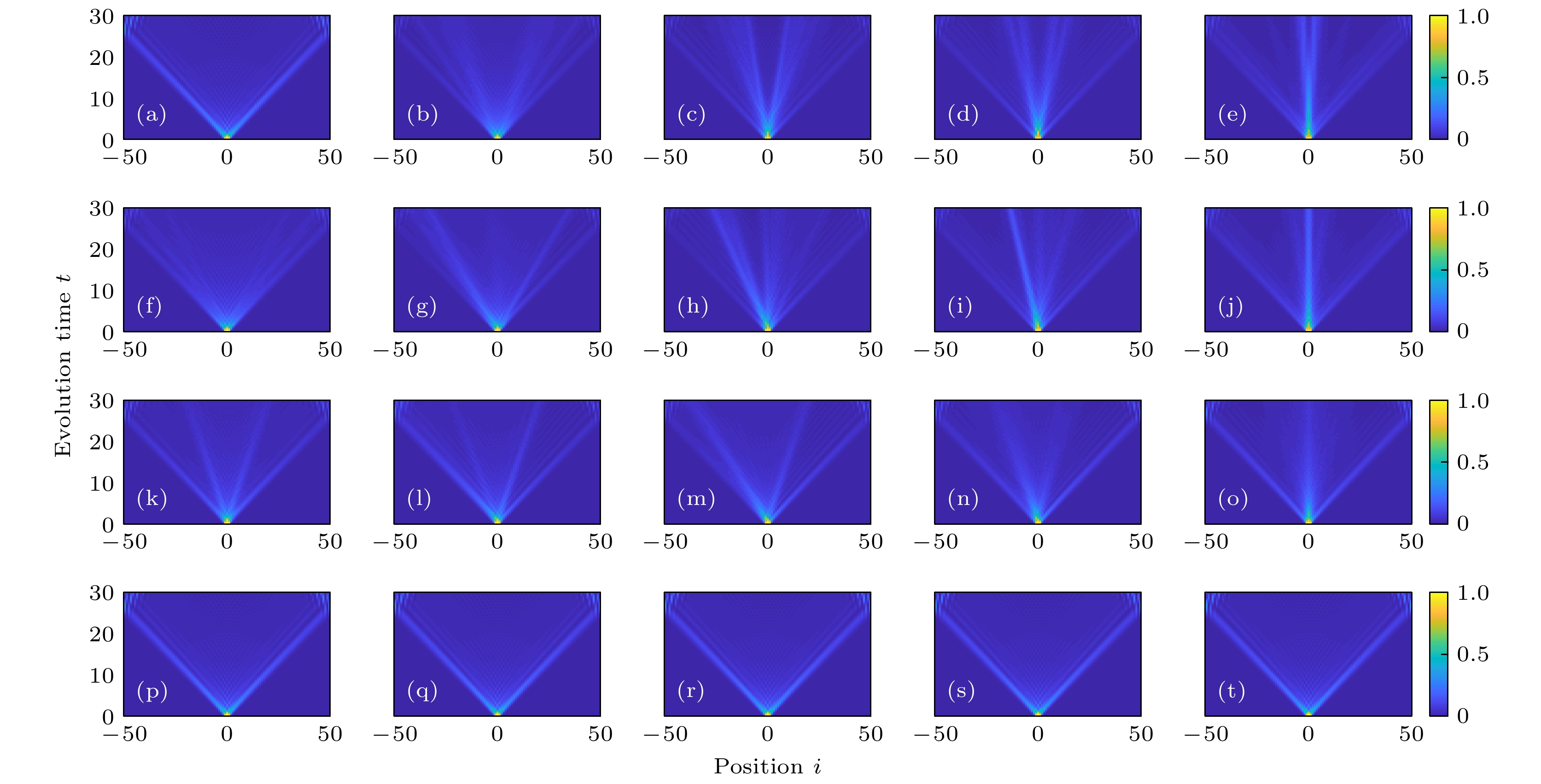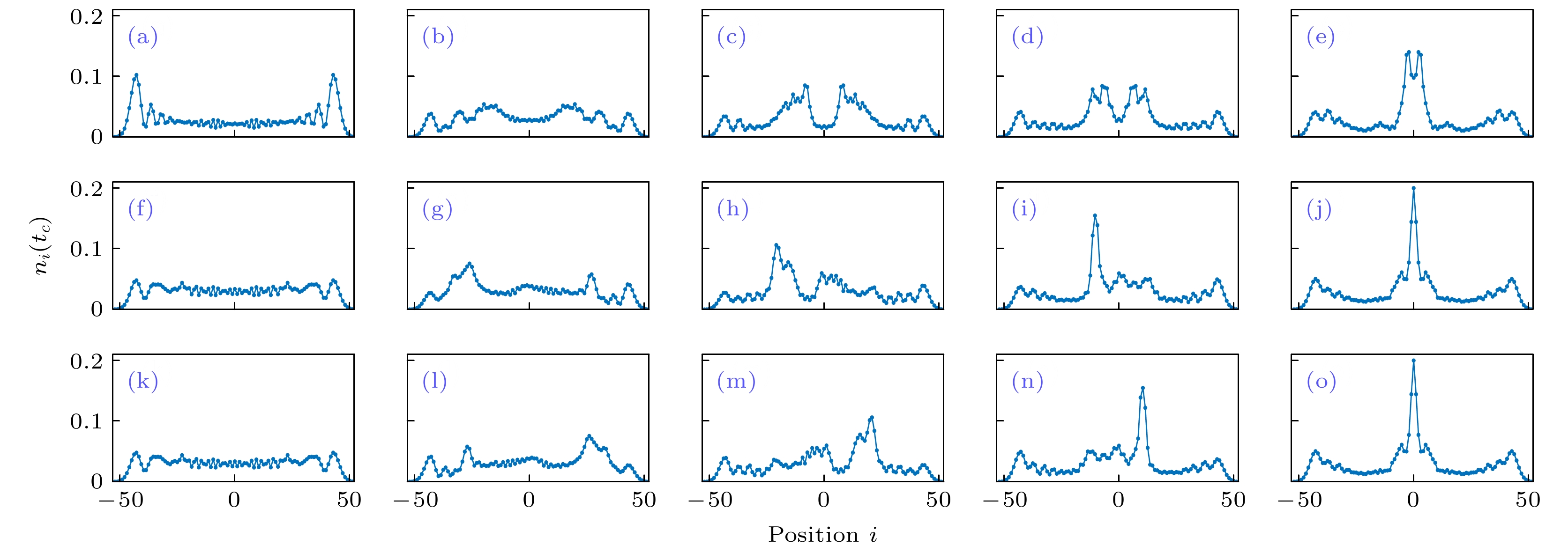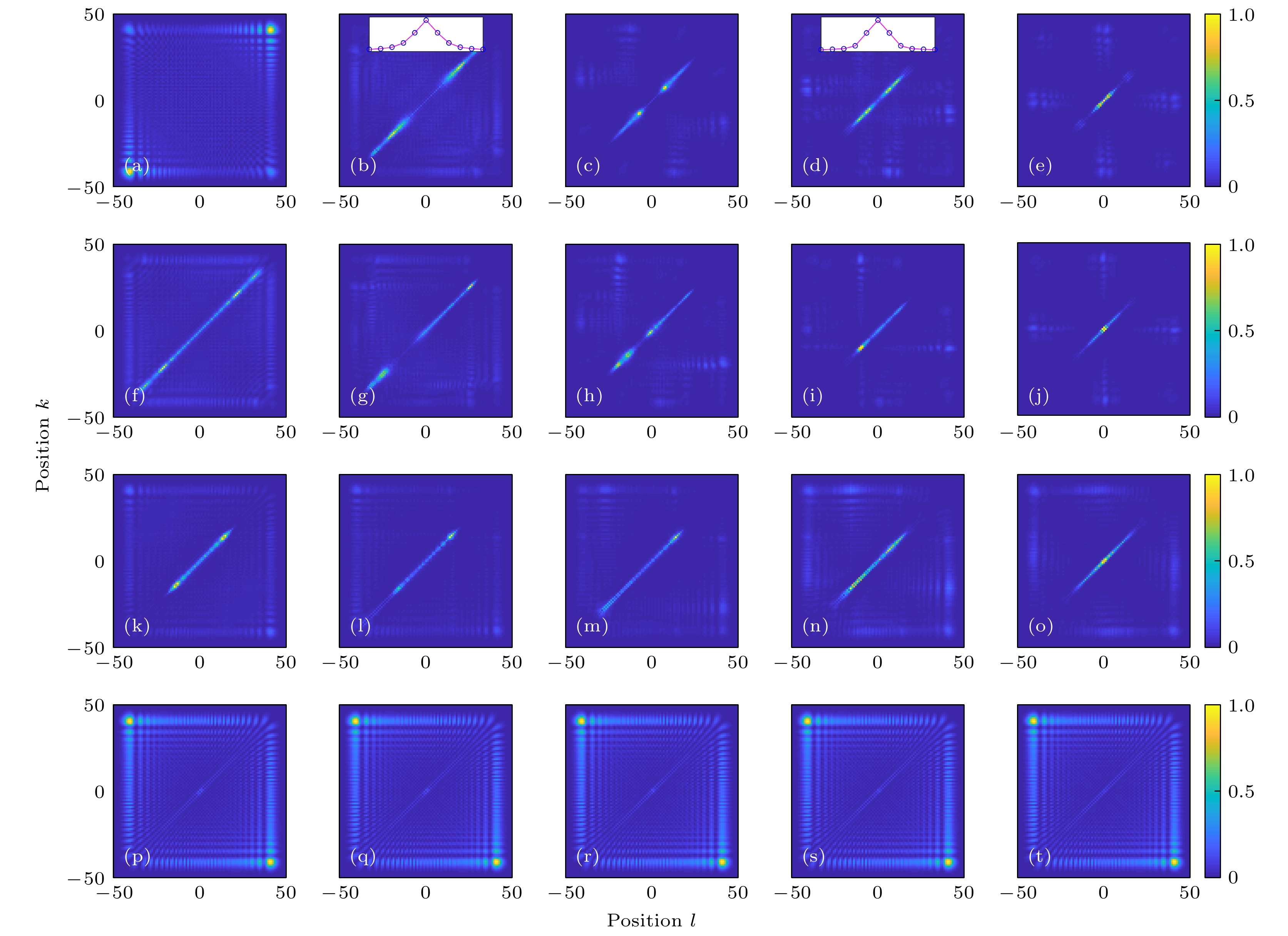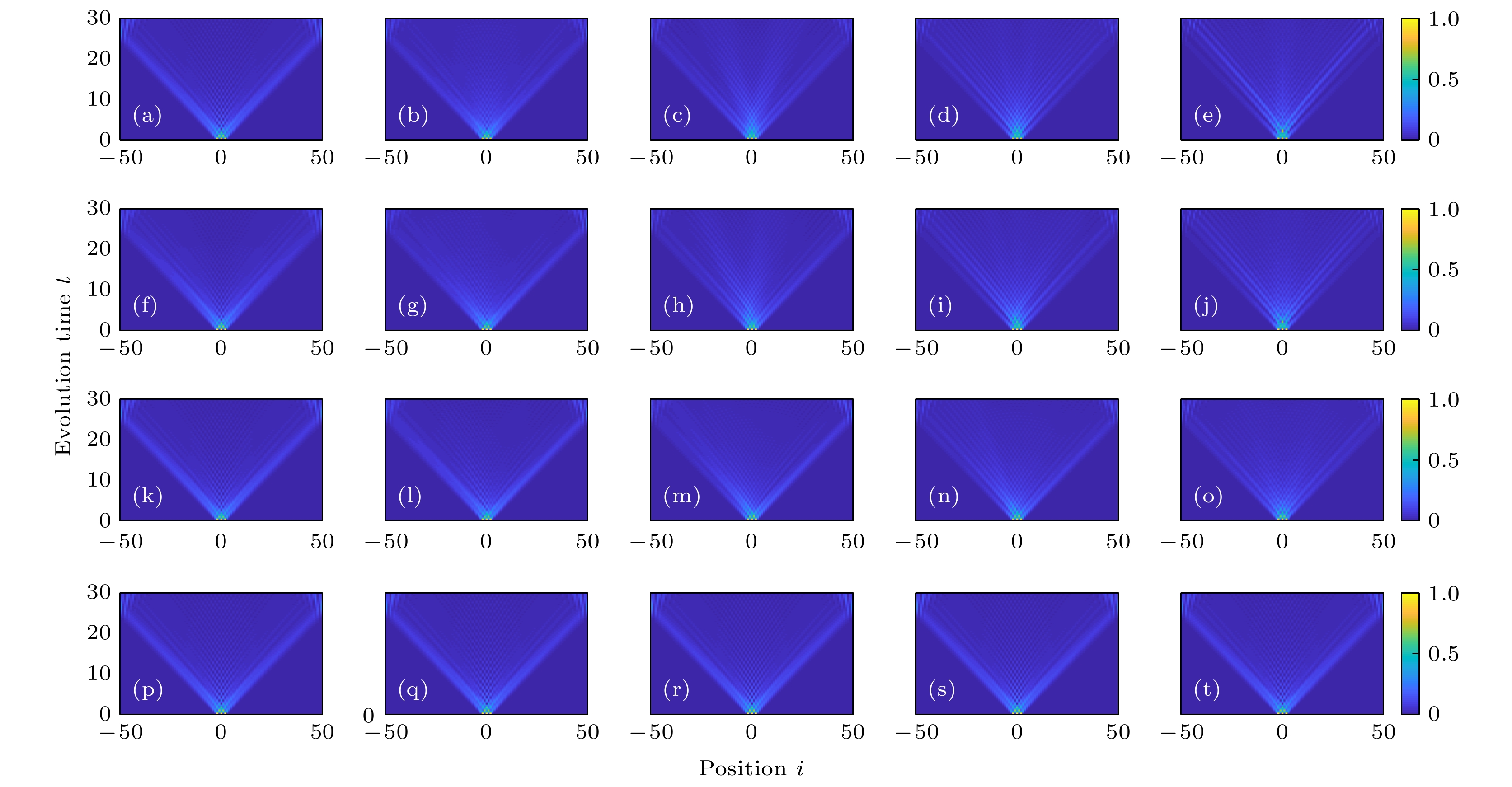-
任意子介于玻色子与费米子之间, 遵从奇特的分数统计, 隐含着许多有趣的物理特性. 本文研究了一维晶格中相互作用全同任意子的少体量子动力学及其量子关联性质. 基于严格的数值方法, 分析了任意子在晶格中局域粒子密度分布的动力学演化过程. 结果表明, 分数统计可以明显影响任意子动力学演化过程中实空间的局域粒子密度分布, 产生新的动力学结构. 特别地, 当存在相互作用时, 分数统计粒子的局域粒子密度分布会呈现有趣的依赖于相互作用性质的不对称性. 最后计算了任意子的密度密度关联, 分析了粒子统计性质和相互作用对体系量子关联的调制, 同时进一步证 实了任意子分数统计在实空间中的动力学效应.Anyons, namely particles obeying fractional quantum statistics that interpolate between bosons and fermions, possess a lot of new and exotic physical properties related to the particle exchange statistics. In this work, we explore the few-body quantum dynamics and quantum correlations of indistinguishable anyons with on-site interactions in one-dimensional lattices within the scheme of three-body continuous-time quantum walks. By employing a time-evolving block decimation (TEBD) algorithm, we numerically calculate the dynamical evolution process of the local density distribution of anyons among the whole lattice. Numerical simulations shown in the main text mainly focus on a three-body initial state as
$ \left|\psi(t=0)\right>=\hat{a}_{-1}^{\dagger}\hat{a}_{0}^{\dagger}\hat{a}_{1}^{\dagger}\left|0\right>$ , in which three particles are located on neighbouring sites at lattice centre. This choice of initial state features that the three particles influence one another most strongly, while we have also implemented numerical simulations on other choices of three-body initial states as are discussed in appendix. It is shown that the local density distribution of anyons is dramatically altered by fractional particle statistics with new dynamical structure showing up during the time evolution. For free anyons, an inner cone emerges as the statistical parameter increases, while the outer cone remains robust all along. When the on-site interaction joins in, the structure of the inner cone is further modified with new features. Specifically, for interaction of finite strength, an exotic dynamical asymmetry in real space, is clearly demonstrated during the time evolution of the local density distribution for particles within the fractional statistics regime. However, for boson limit and pseudofermion limit, the time evolution of the local density distribution keeps symmetric as the three-body initial state. And remarkably, the dynamical asymmetry is interaction-dependent manifested as the local density distribution of anyons favors opposite side of the lattice for repulsive and attractive interaction, respectively. Moreover, when the on-site interaction is further increased to hard-core limit, the dynamical asymmetry will then be largely suppressed. We also calculate the density-density correlations for anyons before they reach the lattice boundary to reveal the interesting effect of fractional statistics on quantum correlations. It is shown that the inner cone corresponds to co-walking of anyons, while the outer cone is related to individual walking and is immune to the variation of statistical parameter. Furthermore, the exotic real-space asymmetry originated from the interplay of fractional statistics and finite interaction is also shown up in the density-density correlations.-
Keywords:
- indistinguishable anyons /
- fractional statistics /
- multi-particle quantum walk /
- dynamical asymmetry
[1] Farhi E, Gutmann S 1998 Phys. Rev. A 58 915
 Google Scholar
Google Scholar
[2] Aharonov Y, Davidovich L, Zagury N 1993 Phys. Rev. A 48 1687
 Google Scholar
Google Scholar
[3] Kempe J 2003 Contemp. Phys. 44 307
 Google Scholar
Google Scholar
[4] Manouchehri K, Wang J B 2013 Physical Implementation of Quantum Walks (Berlin: Springer)
[5] Karski M, Förster L, Choi J M, Steffen A, Alt W, Meschede D, Widera A 2009 Science 325 174
 Google Scholar
Google Scholar
[6] Preiss P M, Ma R, Tai M E, Lukin A, Rispoli M, Zupancic P, Lahini Y, Islam R, Greiner M 2015 Science 347 1229
 Google Scholar
Google Scholar
[7] Broome M A, Fedrizzi A, Lanyon B P, Kassal I, Aspuru-Guzik A, White A G 2010 Phys. Rev. Lett. 104 153602
 Google Scholar
Google Scholar
[8] Xue P, Zhang R, Qin H, Zhan X, Bian Z H, Li J, Sanders B C 2015 Phys. Rev. Lett. 114 140502
 Google Scholar
Google Scholar
[9] Ramasesh V V, Flurin E, Rudner M, Siddiqi I, Yao N Y 2017 Phys. Rev. Lett. 118 130501
 Google Scholar
Google Scholar
[10] Yan Z, Zhang Y R, Gong M, et al. 2019 Science 364 753
 Google Scholar
Google Scholar
[11] Ye Y S, Ge Z Y, Wu Y L, et al. 2019 Phys. Rev. Lett. 123 050502
 Google Scholar
Google Scholar
[12] Sansoni L, Sciarrino F, Vallone G, Mataloni P, Crespi A, Ramponi R, Osellame R 2012 Phys. Rev. Lett. 108 010502
 Google Scholar
Google Scholar
[13] Du J F, Li H, Xu X D, Shi M J, Wu J H, Zhou X Y, Han R D 2003 Phys. Rev. A 67 042316
 Google Scholar
Google Scholar
[14] Schmitz H, Matjeschk R, Schneider C, Glueckert J, Enderlein M, Huber T, Schaetz T 2009 Phys. Rev. Lett. 103 090504
 Google Scholar
Google Scholar
[15] Ambainis A 2003 Int. J. Quantum Inf. 1 507
 Google Scholar
Google Scholar
[16] Childs A M, Gosset D, Webb Z 2013 Science 339 791
 Google Scholar
Google Scholar
[17] Zatelli F, Benedetti C, Paris M G A 2020 Entropy 22 1321
 Google Scholar
Google Scholar
[18] Venegas-Andraca S E 2012 Quantum Inf. Process. 11 1015
 Google Scholar
Google Scholar
[19] Kitagawa T, Broome M A, Fedrizzi A, et al. 2012 Nat. Commun. 3 882
 Google Scholar
Google Scholar
[20] Kitagawa T, Rudner M S, Berg E, Demler E 2010 Phys. Rev. A 82 033429
[21] Wang K K, Li T Y, Xiao L, Han Y W, Yi W, Xue P 2021 Phys. Rev. Lett. 127 270602
 Google Scholar
Google Scholar
[22] Liu W J, Ke Y G, Zhang L, Lee C H 2019 Phys. Rev. A 99 063614
 Google Scholar
Google Scholar
[23] Tarallo M G, Mazzoni T, Poli N, Sutyrin D V, Zhang X, Tino G M 2014 Phys. Rev. Lett. 113 023005
 Google Scholar
Google Scholar
[24] Yin Y, Katsanos D E, Evangelou S N 2008 Phys. Rev. A 77 022302
 Google Scholar
Google Scholar
[25] Beggi A, Buscemi F, Bordone P 2016 Quantum Inf. Process. 15 3711
 Google Scholar
Google Scholar
[26] Li Z J, Wang J B 2015 Sci. Rep. 5 13585
 Google Scholar
Google Scholar
[27] Wang L M, Wang L, Zhang Y B 2014 Phys. Rev. A 90 063618
 Google Scholar
Google Scholar
[28] Qin X Z, Ke Y G, Guan X W, Li Z B, Andrei N, Lee C H 2014 Phys. Rev. A 90 062301
 Google Scholar
Google Scholar
[29] Wang L, Hao Y J, Chen S 2010 Phys. Rev. A 81 063637
 Google Scholar
Google Scholar
[30] Ganahl M, Rabel E, Essler F H L, Evertz H G 2012 Phys. Rev. Lett. 108 077206
 Google Scholar
Google Scholar
[31] Sarkar S, Sowiński T 2020 Phys. Rev. A 102 043326
 Google Scholar
Google Scholar
[32] Wang L, Hao Y J, Chen S 2008 Eur. Phys. J. D 48 229
 Google Scholar
Google Scholar
[33] Kraus Y E, Lahini Y, Ringel Z, Verbin M, Zilberberg O 2012 Phys. Rev. Lett. 109 106402
 Google Scholar
Google Scholar
[34] Wang L, Liu N, Chen S, Zhang Y B 2015 Phys. Rev. A 92 053606
 Google Scholar
Google Scholar
[35] Wang L, Liu N, Chen S, Zhang Y B 2017 Phys. Rev. A 95 013619
 Google Scholar
Google Scholar
[36] Cai X M, Yang H T, Shi H L, Lee C H, Andrei N, Guan X W 2021 Phys. Rev. Lett. 127 100406
 Google Scholar
Google Scholar
[37] Wilczek F 1982 Phys. Rev. Lett. 49 957
 Google Scholar
Google Scholar
[38] Halperin B I 1984 Phys. Rev. Lett. 52 1583
 Google Scholar
Google Scholar
[39] Haldane F D M 1991 Phys. Rev. Lett. 67 937
 Google Scholar
Google Scholar
[40] Stern A 2008 Ann. Phys. 323 204
 Google Scholar
Google Scholar
[41] Bartolomei H, Kumar M, Bisognin R, et al. 2020 Science 368 173
 Google Scholar
Google Scholar
[42] Nakamura J, Liang S, Gardner G C, Manfra M J 2020 Nat. Phys. 16 931
 Google Scholar
Google Scholar
[43] Nayak C, Simon S H, Stern A, Freedman M, Das Sarma S 2008 Rev. Mod. Phys. 80 1083
 Google Scholar
Google Scholar
[44] Batchelor M T, Guan X W, Oelkers N 2006 Phys. Rev. Lett. 96 210402
 Google Scholar
Google Scholar
[45] Kundu A 1999 Phys. Rev. Lett. 83 1275
 Google Scholar
Google Scholar
[46] Girardeau M D 2006 Phys. Rev. Lett. 97 100402
 Google Scholar
Google Scholar
[47] Keilmann T, Lanzmich S, McCulloch I, Roncaglia M 2011 Nat. Commun. 2 361
 Google Scholar
Google Scholar
[48] Greschner S, Santos L 2015 Phys. Rev. Lett. 115 053002
 Google Scholar
Google Scholar
[49] Vidal G 2003 Phys. Rev. Lett. 91 147902
 Google Scholar
Google Scholar
[50] Hao Y J, Zhang Y B, Chen S 2008 Phys. Rev. A 78 023631
 Google Scholar
Google Scholar
-
图 1 三任意子在一维晶格中局域粒子密度分布的时间演化过程. 晶格尺寸为
$ L=101 $ . 从左至右各列对应的统计参数χ的取值为0, 0.25, 0.5, 0.75, 1. 从上至下各行对应的相互作用强度U的取值为0, –1, –4, –80Fig. 1. Dynamical evolution of the local density distribution of three identical anyons among one-dimensional lattices of
$ L=101 $ . From left to right, the statistical parameter χ is set to be 0, 0.25, 0.5, 0.75, 1. From top to bottom, the on-site interaction strength U takes value 0, –1, –4, –80, respectively图 2 不同量子统计及不同在位相互作用下, 任意子于时刻
$t=t_{\rm{c}}=22$ 在一维晶格中的局域密度分布. 从左到右, 统计参数χ取值为0, 0.25, 0.5, 0.75, 1. 从上至下各行对应的相互作用强度U的取值为0, –1, 1Fig. 2. Local density profiles of anyons among the whole lattice at time
$t=t_{\rm{c}}=22$ . From left to right, the statistical parameter χ is set to be 0, 0.25, 0.5, 0.75, 1. From top to bottom, the on-site interaction strength U takes values 0, –1, 1, respectively图 3 三任意子量子行走过程中的密度密度关联
$\varGamma_{lk}(t)/\varGamma_{lk}^{{\rm{max}}}(t)$ , 图中对应时刻为$t=t_{\rm{c}}=22$ . 从左至右各列对应的统计参数χ的取值为0, 0.25, 0.5, 0.75, 1. 从上至下各行对应的相互作用强度U的取值为0, –1, –4, –80Fig. 3. The density-density correlations
$\varGamma_{lk}(t)/\varGamma_{lk}^{{\rm{max}}}(t)$ of the three identical anyons at time$t=t_{\rm{c}}=22$ . From left to right, the statistical parameter χ is set to be 0, 0.25, 0.5, 0.75, 1. From top to bottom, the on-site interaction strength U takes value 0, –1, –4, –80, respectively图 A1 三任意子态
$ \left|\psi(t=0)\right > =\hat{a}_{-2}^{\dagger}\hat{a}_{0}^{\dagger}\hat{a}_{2}^{\dagger}\left|0\right > $ 在一维晶格中动力学演化过程. 晶格尺寸为$ L=101 $ . 从左至右各列对应的统计参数χ的取值为0, 0.25, 0.5, 0.75, 1. 从上至下各行对应的相互作用强度U的取值为0, –1, –4, –80Fig. A1. (Color online) Dynamical evolution of the three-anyon state
$ \left|\psi(t=0)\right > =\hat{a}_{-2}^{\dagger}\hat{a}_{0}^{\dagger}\hat{a}_{2}^{\dagger}\left|0\right > $ among one-dimensional lattices of$ L=101 $ . From left to right, the statistical parameter χ is set to be 0, 0.25, 0.5, 0.75, 1. From top to bottom, the on-site interaction strength U takes value 0, –1, –4, –80, respectively图 A2 不同量子统计及不同在位相互作用下, 任意子于时刻
$t=t_{\rm{c}}=9$ 在一维晶格中的局域密度分布. 任意子的量子初态为$ \left|\psi(t=0)\right > =\hat{a}_{-2}^{\dagger}\hat{a}_{0}^{\dagger}\hat{a}_{2}^{\dagger}\left|0\right > $ . 从左到右统计参数χ取值为0, 0.25, 0.5, 0.75, 1. 从上至下各行对应的相互作用强度U的取值为0, –1, 1Fig. A2. Local density profiles of anyons among the whole lattice at time
$t=t_{\rm{c}}=9$ . The initial state is chosen as$ \left|\psi(t=0)\right > =\hat{a}_{-2}^{\dagger}\hat{a}_{0}^{\dagger}\hat{a}_{2}^{\dagger}\left|0\right > $ . From left to right, the statistical parameter χ is set to be 0, 0.25, 0.5, 0.75, 1. From top to bottom, the on-site interaction strength U takes values 0, –1, 1, respectively -
[1] Farhi E, Gutmann S 1998 Phys. Rev. A 58 915
 Google Scholar
Google Scholar
[2] Aharonov Y, Davidovich L, Zagury N 1993 Phys. Rev. A 48 1687
 Google Scholar
Google Scholar
[3] Kempe J 2003 Contemp. Phys. 44 307
 Google Scholar
Google Scholar
[4] Manouchehri K, Wang J B 2013 Physical Implementation of Quantum Walks (Berlin: Springer)
[5] Karski M, Förster L, Choi J M, Steffen A, Alt W, Meschede D, Widera A 2009 Science 325 174
 Google Scholar
Google Scholar
[6] Preiss P M, Ma R, Tai M E, Lukin A, Rispoli M, Zupancic P, Lahini Y, Islam R, Greiner M 2015 Science 347 1229
 Google Scholar
Google Scholar
[7] Broome M A, Fedrizzi A, Lanyon B P, Kassal I, Aspuru-Guzik A, White A G 2010 Phys. Rev. Lett. 104 153602
 Google Scholar
Google Scholar
[8] Xue P, Zhang R, Qin H, Zhan X, Bian Z H, Li J, Sanders B C 2015 Phys. Rev. Lett. 114 140502
 Google Scholar
Google Scholar
[9] Ramasesh V V, Flurin E, Rudner M, Siddiqi I, Yao N Y 2017 Phys. Rev. Lett. 118 130501
 Google Scholar
Google Scholar
[10] Yan Z, Zhang Y R, Gong M, et al. 2019 Science 364 753
 Google Scholar
Google Scholar
[11] Ye Y S, Ge Z Y, Wu Y L, et al. 2019 Phys. Rev. Lett. 123 050502
 Google Scholar
Google Scholar
[12] Sansoni L, Sciarrino F, Vallone G, Mataloni P, Crespi A, Ramponi R, Osellame R 2012 Phys. Rev. Lett. 108 010502
 Google Scholar
Google Scholar
[13] Du J F, Li H, Xu X D, Shi M J, Wu J H, Zhou X Y, Han R D 2003 Phys. Rev. A 67 042316
 Google Scholar
Google Scholar
[14] Schmitz H, Matjeschk R, Schneider C, Glueckert J, Enderlein M, Huber T, Schaetz T 2009 Phys. Rev. Lett. 103 090504
 Google Scholar
Google Scholar
[15] Ambainis A 2003 Int. J. Quantum Inf. 1 507
 Google Scholar
Google Scholar
[16] Childs A M, Gosset D, Webb Z 2013 Science 339 791
 Google Scholar
Google Scholar
[17] Zatelli F, Benedetti C, Paris M G A 2020 Entropy 22 1321
 Google Scholar
Google Scholar
[18] Venegas-Andraca S E 2012 Quantum Inf. Process. 11 1015
 Google Scholar
Google Scholar
[19] Kitagawa T, Broome M A, Fedrizzi A, et al. 2012 Nat. Commun. 3 882
 Google Scholar
Google Scholar
[20] Kitagawa T, Rudner M S, Berg E, Demler E 2010 Phys. Rev. A 82 033429
[21] Wang K K, Li T Y, Xiao L, Han Y W, Yi W, Xue P 2021 Phys. Rev. Lett. 127 270602
 Google Scholar
Google Scholar
[22] Liu W J, Ke Y G, Zhang L, Lee C H 2019 Phys. Rev. A 99 063614
 Google Scholar
Google Scholar
[23] Tarallo M G, Mazzoni T, Poli N, Sutyrin D V, Zhang X, Tino G M 2014 Phys. Rev. Lett. 113 023005
 Google Scholar
Google Scholar
[24] Yin Y, Katsanos D E, Evangelou S N 2008 Phys. Rev. A 77 022302
 Google Scholar
Google Scholar
[25] Beggi A, Buscemi F, Bordone P 2016 Quantum Inf. Process. 15 3711
 Google Scholar
Google Scholar
[26] Li Z J, Wang J B 2015 Sci. Rep. 5 13585
 Google Scholar
Google Scholar
[27] Wang L M, Wang L, Zhang Y B 2014 Phys. Rev. A 90 063618
 Google Scholar
Google Scholar
[28] Qin X Z, Ke Y G, Guan X W, Li Z B, Andrei N, Lee C H 2014 Phys. Rev. A 90 062301
 Google Scholar
Google Scholar
[29] Wang L, Hao Y J, Chen S 2010 Phys. Rev. A 81 063637
 Google Scholar
Google Scholar
[30] Ganahl M, Rabel E, Essler F H L, Evertz H G 2012 Phys. Rev. Lett. 108 077206
 Google Scholar
Google Scholar
[31] Sarkar S, Sowiński T 2020 Phys. Rev. A 102 043326
 Google Scholar
Google Scholar
[32] Wang L, Hao Y J, Chen S 2008 Eur. Phys. J. D 48 229
 Google Scholar
Google Scholar
[33] Kraus Y E, Lahini Y, Ringel Z, Verbin M, Zilberberg O 2012 Phys. Rev. Lett. 109 106402
 Google Scholar
Google Scholar
[34] Wang L, Liu N, Chen S, Zhang Y B 2015 Phys. Rev. A 92 053606
 Google Scholar
Google Scholar
[35] Wang L, Liu N, Chen S, Zhang Y B 2017 Phys. Rev. A 95 013619
 Google Scholar
Google Scholar
[36] Cai X M, Yang H T, Shi H L, Lee C H, Andrei N, Guan X W 2021 Phys. Rev. Lett. 127 100406
 Google Scholar
Google Scholar
[37] Wilczek F 1982 Phys. Rev. Lett. 49 957
 Google Scholar
Google Scholar
[38] Halperin B I 1984 Phys. Rev. Lett. 52 1583
 Google Scholar
Google Scholar
[39] Haldane F D M 1991 Phys. Rev. Lett. 67 937
 Google Scholar
Google Scholar
[40] Stern A 2008 Ann. Phys. 323 204
 Google Scholar
Google Scholar
[41] Bartolomei H, Kumar M, Bisognin R, et al. 2020 Science 368 173
 Google Scholar
Google Scholar
[42] Nakamura J, Liang S, Gardner G C, Manfra M J 2020 Nat. Phys. 16 931
 Google Scholar
Google Scholar
[43] Nayak C, Simon S H, Stern A, Freedman M, Das Sarma S 2008 Rev. Mod. Phys. 80 1083
 Google Scholar
Google Scholar
[44] Batchelor M T, Guan X W, Oelkers N 2006 Phys. Rev. Lett. 96 210402
 Google Scholar
Google Scholar
[45] Kundu A 1999 Phys. Rev. Lett. 83 1275
 Google Scholar
Google Scholar
[46] Girardeau M D 2006 Phys. Rev. Lett. 97 100402
 Google Scholar
Google Scholar
[47] Keilmann T, Lanzmich S, McCulloch I, Roncaglia M 2011 Nat. Commun. 2 361
 Google Scholar
Google Scholar
[48] Greschner S, Santos L 2015 Phys. Rev. Lett. 115 053002
 Google Scholar
Google Scholar
[49] Vidal G 2003 Phys. Rev. Lett. 91 147902
 Google Scholar
Google Scholar
[50] Hao Y J, Zhang Y B, Chen S 2008 Phys. Rev. A 78 023631
 Google Scholar
Google Scholar
计量
- 文章访问数: 6365
- PDF下载量: 121
- 被引次数: 0

















 下载:
下载:


















